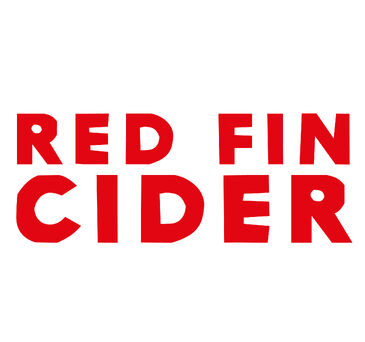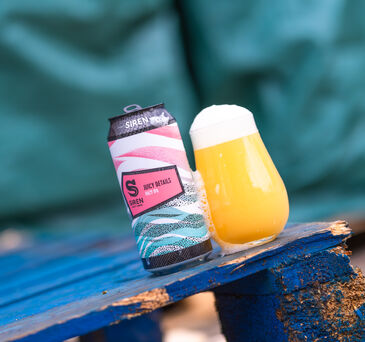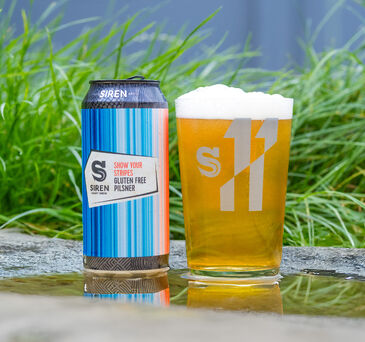
What is a Sour Beer?
The world of sour beer is an expansive one, ever growing with brewers around the world questing to create the perfect mother-puckeringly sour beverage. One of our very own brewers, Hayley, has taken the time out of her busy schedule to write this detailed blog article on just what goes into creating a great sour beer.
AN INTRODUCTION TO SOUR BEER
If you’ve managed to find some Summer in a beer garden, or you’re a regular in your local bottle shop, you won’t have failed to notice that an increasing number of traditional lager, ale, cider and IPA lovers are having their taste buds tickled by a cheeky alternative. Sour beers aren’t a new kid on the block; they’ve been around for thousands of years. Sadly, with the advent of sterile brewing practices, sour flavours have found themselves in the ‘this beer is off’ category where they remained for quite some time. In more recent times sour beers have not only made a remarkable comeback but their increase in popularity shows no sign of slowing down.
So why is it that sour beers are tempting drinkers away from their favourite tipples? In a nutshell, they serve to satisfy a quest for more and more unusual, unconventional and ‘you have to try this’ flavours. Unlike the bitter or sweetness of traditional beers, high acidity, layered complexity, unruly tang and a sometimes breath gasping tartness are Sour beers’ big hitters.

Brewing sour beer deliberately could be seen as something of a contradiction. Way back in time before sterilisation, pasteurisation and refrigeration came onto the scene, all beers had this sour element. Despite the temporary fall from grace of sour flavours, some breweries - mainly in Belgium - shunned the modern more ‘hygienic’ methods and continued to brew traditionally.
Slowly but surely as demand for more complex flavours seeped into our brewing culture brewers have revisited these traditional methods, or strived to bring back the sour beer using increasingly modern and sophisticated techniques.
Time for a chemistry lesson. How and why is sour beer, sour? What is a sour beer? The main culprit is the low pH/high acidity. This is achieved by the addition of wild yeasts or bacteria which metabolise sugars into a vast array of different acids depending on the species. It is not a dissimilar process to that which is used to make sauerkraut, sourdough, some cheeses, and yoghurt.
In brewing, there are a number of ways this can be done, so let’s delve into a bit more detail.
SPONTANEOUS FERMENTATION
The oldest and most traditional method. In the early days of brewing, it would be common to produce your brew by leaving vessels of fruit and sugary water out in the open for nature to take its course. Wild yeasts and bacteria in the air would ‘infect’ the liquid and begin the fermentation process. The resulting brew would be sour and this would be considered perfectly normal. Some breweries still produce sour beer in this traditional way, allowing naturally occurring organisms to infect the beer which is held in open vessels or huge open tanks known as ‘coolships’, an Anglicised version of the Dutch/Flemish ‘Koelschip’.

Koelschip photo By DirkVE - Own work, CC BY-SA 3.0
A prime example of this are the Lambic and Gueuze beers brewed in Belgium whose special characteristics include pleasant tartness and acidity, undertones of citrus or fruit, a noticeable ‘funk’, ‘new hay’ or ‘barnyard’ flavour and a perfectly crisp, dry mouthfeel. Popular variations of this include the fruited Lambics - notably ‘Kriek’ with morello cherries, and ‘Framboise’ with raspberries.
Sounds amazing, but the downside of this is that it can take months or even years of maturation to give a spontaneously fermented beer time to reach this ideal and sought after complexity of flavour. The science behind what is happening during maturation is complex, but one part of it is down to the particular blend of bacteria or yeast within the beer.
Some of these will initially give the beer what could be considered as ‘off’ flavours, however, given time these flavours can be cleaned up and transformed into the delicious tongue ticklers much revered by the sour beer enthusiast. A great example of this is the production of butyric acid which I’m told has the less than delightful flavour of baby vomit… I’d like a word with whomever discovered that. This is where the slow yet essential work of a yeast variety Brettanomyces comes in.
‘Brett’ is able to break down butyric acid into ethyl butyrate, which tastes like tropical fruits – voila! So allowing time for nature to properly do its work needs patience. However for some breweries it is just not commercially viable to tie up their equipment for such long periods, so let’s introduce another method of producing a delicious Sour.
KETTLE SOURING
A popular method that involves souring the beer under controlled conditions to produce a much quicker turnaround time, a Kettle Sour can be produced in as little as days or weeks instead of months or years. With this method, the souring process is in the hands of the brewer. Wort with little or no hop content is boiled in the kettle as usual and then cooled to around 35 Celsius. At this point the souring agent, typically lactobacillus, is deliberately added to the kettle and acidification is allowed to continue for 24 to 48 hours depending on the level of acidity required.
At this point, the brewer halts the process by boiling the wort in the kettle again, killing the bacteria. After cooling once more, the wort can be transferred to a fermentation vessel and fermented with brewer’s yeast in the same way as any other beer. Time and control are the big plus points with this method.
Kettle souring produces a cleaner flavour profile than its spontaneously fermented cousin. This lends itself well to being augmented in all manner of ways in order to keep up with the ever increasing demand for unusual and awe inspiring flavour combinations. Kettle Sours include the likes of Berliner Weisse and the German Gose.
Of course, we must not forget our fabulous Siren Kettle Sours, ‘Pompelmocello’, ‘Cherry Negroni Sour’, and ‘Red Berry Rhapsody’, to name a few. Try them out, and enjoy the sour revolution! Calypso even had a space in our flagship range for many years, before the general demand for heavily fruited sours sadly kicked the likes of Calypso into touch somewhat.

MIXED FERM
Let’s make things a little more complicated now by introducing a third sour brewing method. It’s really a combination of the two methods we’ve already looked at, and unsurprisingly is named ‘Mixed Culture Fermentation’. This involves fermenting lightly hopped wort in steel tanks with both brewer’s yeast (or a mixture of this and unconventional yeast) and bacteria - typically lactobacillus.
Fermentation is allowed to continue for several weeks and the results can then be either bottled young or barrelled in oak casks to allow the bacteria and wild yeasts to increase the concentration of acids over time. They initially form organic acids which are then converted into fruity esters. Mixed Culture Fermentation produces a refreshingly fruity and tart beer, but the outcome can be a little unpredictable due to the fact that different cultures are added at the same time. Popular sours using this method are the Flanders Red Ales and Flanders Brown Ales (a little nod here to my personal favourite ‘Duchesse de Bourgogne’).
 Our 2018 collaboration with Yeastie Boys saw an overnight fermentation in our brewery yard, with barrels stored under a tent.
Our 2018 collaboration with Yeastie Boys saw an overnight fermentation in our brewery yard, with barrels stored under a tent.
For some versions of these styles, an extra layer of complexity is added when the brewer blends young sours with their matured counterparts. These matured beers are often stored for several years in giant oak ‘foeders’. The brewer can then select the contents of different foeders for their flavour and blend these in specific ratios with the young beer.
These elaborate blends are often referred to as ‘Grand Cru’. However, that’s not where the complexity ends for these beers. The brewer also has fruit in their arsenal and will sometimes infuse these beers with cherries and other fruits that work to naturally enhance the beer’s core flavours, whilst also bringing a complimentary sweetness to the taste rollercoaster.
IN CONCLUSION...
So there we have it, a short stroll through the sometimes bewildering, always exciting world of producing a great sour beer. But where do we go from here?? In recent years, there have been some novel developments with the discovery of yeast species which can produce both alcohol and lactic acid during fermentation.
One such yeast, known as Philly Sour, a unique species of Lanancea, removes the need to use bacteria and greatly reduces the number of steps involved in producing a sour beer. For those of you who haven’t been fortunate or courageous enough to try one of these fascinating little beasts yet, it’s time to grasp the nettle.
A word of advice from a seasoned sour lover: there won’t be a moment of instant epiphany, and in fact your face will probably contort á la sour apple sweets and sherbet lemons of younger days. Be patient, sip slowly and when the lip sucking and cheek puckering subsides the underlying gamut of delightful yet uncompromising flavours will unfurl. For those of a timid disposition, a good place to start is with a sour which has had fruit or fruit puree added to balance the tartness with a little natural sweetness (try Red Berry Rhapsody out for size!)
These will be the first steps on a journey which will bring a whole new level to your beer enjoyment, and open your senses to the kaleidoscope of sour beer flavours. Enjoy!
.jpg)
DISCOVER OUR OTHER STORIES
Siren x Red Fin Press Release
Read MoreWe're pleased to announce a new partnership with Red Fin Cider which is set to provide quality flavourful beverages to pubs, bars and restaurants, while remaining a non-financial agreement. Scroll down...
October Newsletter
Read MoreAutumn has come upon the brewery in a flurry of falling leaves and a murmuring of excitement as both days, and beers, grow darker - more on that soon. We’ve got a lot coming up on our radar between...
Show Your Stripes with the University of Reading
Read MoreHere at Siren, we’ve always believed that beer can do more than just quench your thirst… it can inspire, it can intrigue and for sure, it can start a conversation.




